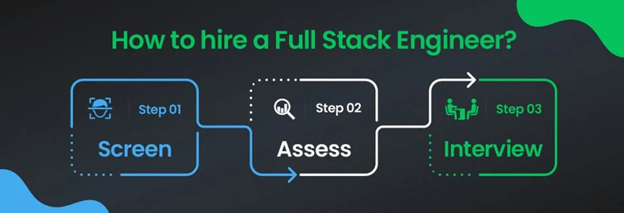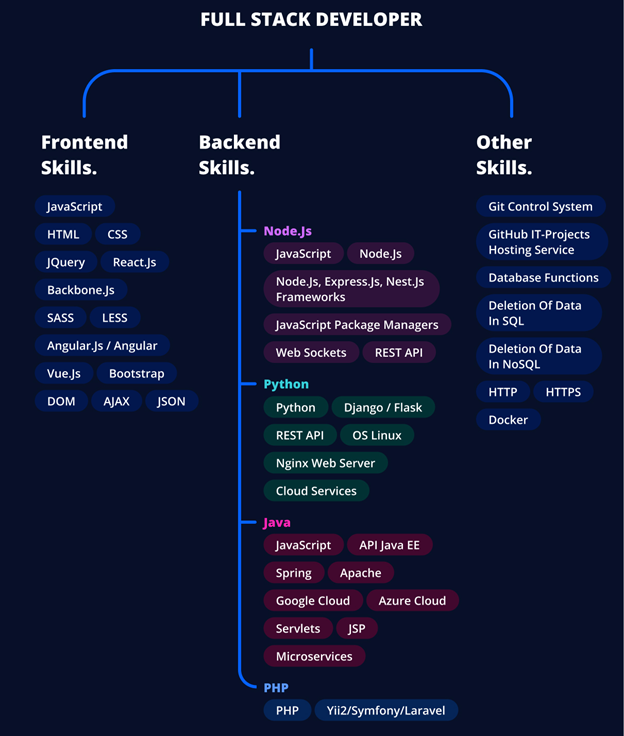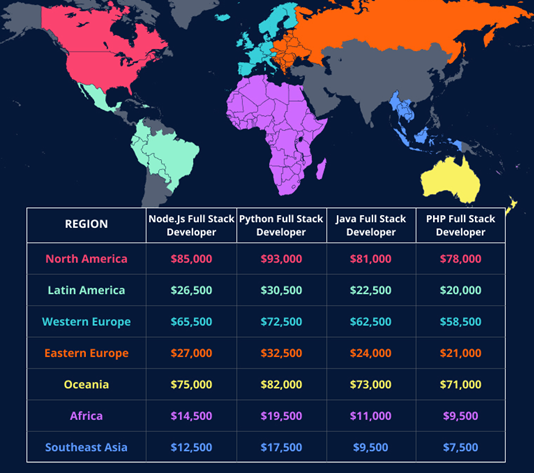What You Need to Know on How to Hire Full Stack Developers?

The term “full-stack developer” first appeared in 2012, both in job postings and online articles. Soon enough, businesses realized they were losing money by employing proficient programmers in only one language. As a result, it has become increasingly common to employ a full-stack web developer who can tackle a wide range of problems.
Simply having a great idea for an app is not enough. The most challenging part of creating an app is assembling a top-notch development team. You should invest in full-stack developers who can tackle everything in accordance with your goals, resources, and financial constraints. But how and where to locate such is still an open topic.
Discover what to look for in a full-stack developer with the help of this blog. A few other points need to be covered before delving into the specifics of full-stack developers.
A full-stack developer is an expert programmer fluent in websites’ front and back ends and several web application frameworks. Depending on the project’s needs, they may adopt new technology swiftly.
Several subfields within software engineering include front-end and back-end development, mobile app development, testing for the web and mobile platforms, and so on. A full-stack developer has extensive knowledge of software development, including creating websites, applications, and software. They are versatile in various technological areas, including front-end and back-end coding, database management, application programming interfaces, and version control systems. Engineers across the full stack employ languages and tools such as JavaScript, HTML, and SQL to build apps that prioritize the user’s experience while meeting the business’s needs. However, it can be challenging to find a skilled full-stack developer.
Full-stack developers frequently work on websites and technologies that are significantly larger and more complicated than those that were common in the past. While it’s true that no single employee can master every aspect of a company’s technology stack, those that do are more valuable to potential employers. Instead of hiring a small group of experts, many businesses are looking for developers who can switch gears and handle various tasks. Having a single point of contact who is familiar with all aspects of the project and can oversee its management is more efficient and saves money.
The key responsibilities of a full-stack developer consist of the following.
Full-stack developers are in high demand by businesses because they allow cost savings by eliminating the need to recruit specialists in each individual technology.

Engineers with complete stack expertise are well-versed in front- and back-end development processes. As a result, you must check the foundations of the back-end and front-end development. CSS, HTML, and JavaScript are just a few of the mentioned languages.
If they are a front-end developer, they must consider their familiarity with the server side. This is possible using PHP, SOAP, APIs, REST, Cache, AWS, and others.
As an alternative to the traditional method of finding and employing full-stack engineers, a tech community can help you connect with experienced software experts who have already been vetted. Software engineers from all over the world can network through a developer community. This helps with the goal of resolving issues on a worldwide scale.
GitHub profiles may help you narrow down a large pool of top full-stack developers who focus on mobile and web app development, which is a huge time saver when hiring developers. It is becoming a standard procedure for hiring managers and recruiters to review candidates’ GitHub profiles during the interview process; however, many junior and intermediate coders are unaware of how lately this trend has emerged. This new approach to evaluating developers has sparked widespread interest in how businesses assess contributions to code repositories like GitHub.
Certain ideas about the nature of work have shifted as technological norms have shifted. Repository websites have become increasingly common in recent years. The popularity of open-source software, the simplicity and affordability of hosting, and the growth of app markets have contributed to a broader audience for open-source. These advancements have enabled programmers to showcase their work to prospective employers through their portfolios.
There are several types of full-stack developers, but expertise in JavaScript and related technologies are among the most popular. They will be further discussed in this article.
The frameworks that support many web apps provide an overview of those apps. There are many distinct application frameworks, and each one is written in a unique language. Here are a few of the most common ones:
Django is a Python framework similar to Ruby on Rails in that it employs a model-template-view structure. It promotes rapid innovation and a streamlined, practical layout. It’s second only to Flask in popularity among Python developers.
Rails, created by David Heinemeier Hansson, is a widely used framework. Compared to other frameworks like Java, developers may create lightning-speed applications.
Rails include all the pieces to build an MVC-based, SQLite-backed, database-driven program. In addition, Ruby’s extensive gem library allows you to extend your app’s capabilities in various ways.
Google’s Angular is a framework for creating robust and scalable web applications. It has strong preferences for the design patterns it will accept; however, this is not necessarily a drawback. Since Google is behind this framework, one may anticipate a high degree of attention having been put into the development of the framework.
Microsoft’s ASP.NET is a lightweight and efficient platform for creating. NET-based web applications. ASP.NET offers free hosting through Microsoft Azure and extends the.NET Developer Platform, so while it may not have the same appeal as JavaScript or the Ruby framework, it does have several advantages.
It’s a good option for apps that need to communicate in both directions in real-time, use microservices hosted in docker containers, and require a flexible REST API to support browsers and mobile devices.
One of the most popular PHP frameworks, Laravel, follows the MVC pattern. PHP’s expressive and beautiful syntax makes it a pleasure to write web applications with the language.
The choice of programming language and frameworks is a high-level decision that depends on the nature of the product you’re developing. However, one need not commit to a particular framework to proceed. In reality, many businesses construct their own unique “technology stack” to address specific problems.
As technology stacks mature into a more complex topic, they will eventually impact how you select new employees. Recruiting top developers will be less difficult if your technology stack is widely used. But if your stack is uncommon, it will be more challenging to locate programmers who are well-versed in your particular set of technologies.
This is a topic for another article, but a competent CTO will be able to weigh the pros and cons of your technologies and make an informed choice.
The following are some of the most widely-used technological stacks today:
In order to create dynamic websites, developers often turn to the MEAN stack, which is a set of JavaScript-based tools. In this case, the letters stand for the names of the individual components:
In order to create dynamic websites, developers often turn to the MERN stack, which is a set of JavaScript technologies. The letters stand for the terms:
The LAMP stack is a set of open source technologies that are utilized in the process of developing online applications. It’s an acronym for:
You can find many more stacks; these are just some more common ones. Depending on the primary programming language they specialize in, full-stack developers generally have experience working with one or two other frameworks in addition to a certain combination of technologies.

When the minimum viable product (MVP) is released, the company will learn from its customers what features are needed to complete the software. This will allow the development team to incorporate the requested functions into future app updates. A company that wants to make an MVP should hire full-stack developers because they are the most efficient and cost-effective option.
A full-stack engineer’s skills are in high demand in the present technological landscape. According to a recent Forbes article, full-stack developers may expect to receive more job offers than any other type of software developer in 2022.

The following are some key questions that you can ask:
What to look for in a software engineer in terms of skills and qualifications?
What does a full stack developer do everyday?
The day-to-day responsibilities that are expected of a full-stack developer will differ from one project to the next and from one developer to the next developer’s level of experience. On the other hand, if you examine job descriptions for full-stack engineers, you’ll see that many of them have similar primary duties.
What soft skills should a talented full-stack developer have?
Hiring a full-stack developer throughout 2022 is not easy, as skilled and experienced talents are in high demand. However, once you know what to focus on, the selection process for possible applicants is far less intimidating.
Hopefully, the details presented here must have aided your understanding of what a full-stack developer is and how to find one for your project.
If you need to find a full-stack developer, you can reach out to us. We have a strong team of experienced developers to meet your unique requirements.
Top quality ensured or we work for free
